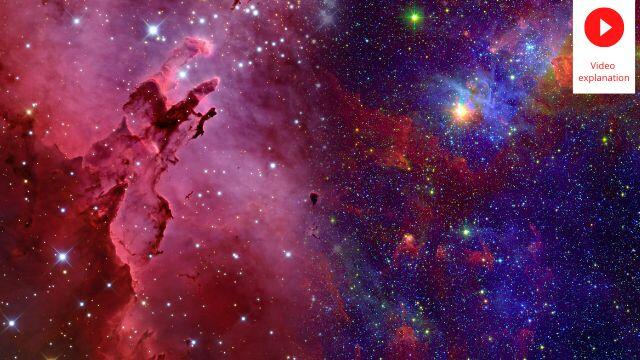States of matter are generally described on the basis of qualities that can be seen or felt. Matter that feels hard and maintains a fixed shape is called a solid; matter that feels wet and maintains its volume but not its shape is called a liquid. Matter that can change both shape and volume is called a gas.
Some introductory chemistry texts name solids, liquids, and gases as the three states of matter, but higher level texts recognize plasma as the fourth state of matter. Like a gas, plasma can change its volume and shape, but unlike a gas, it can also change its electrical charge.
Space and time emerged together 13.787±0.020 billion years ago, and the universe has been expanding ever since. While the spatial size of the entire universe is unknown, the cosmic inflation equation indicates that it must have a minimum diameter of 23 trillion light years, and it is possible to measure the size of the observable universe, which is approximately 93 billion light-years in diameter at the present day.
Solids
A solid has a definite shape and volume because the molecules that make up the solid are packed closely together and move slowly. Solids are often crystalline; examples of crystalline solids include table salt, sugar, diamonds, and many other minerals. Solids are sometimes formed when liquids or gases are cooled; ice is an example of a cooled liquid which has become solid. Other examples of solids include wood, metal, and rock at room temperature.
Liquids
A liquid has a definite volume but takes the shape of its container. Examples of liquids include water and oil. Gases may liquefy when they cool, as is the case with water vapor. This occurs as the molecules in the gas slow down and lose energy. Solids may liquefy when they heat up; molten lava is an example of solid rock which has liquefied as a result of intense heat.
Gases
A gas has neither a definite volume nor a definite shape. Some gases can be seen and felt, while others are intangible for human beings. Examples of gases are air, oxygen, and helium. Earth’s atmosphere is made up of gases including nitrogen, oxygen, and carbon dioxide.
Plasma
Plasma has neither a definite volume nor a definite shape. Plasma often is seen in ionized gases, but it is distinct from a gas because it possesses unique properties. Free electrical charges (not bound to atoms or ions) cause the plasma to be electrically conductive. The plasma may be formed by heating and ionizing a gas. Examples of plasma include stars, lightning, fluorescent lights, and neon signs.
Can you Guess the answer to the question , lets find out!
For more such videos : https://www.youtube.com/c/ExperiHub?sub_confirmation=1
For more Science related blogs and videos : https://experihub.com/did-you-know/

